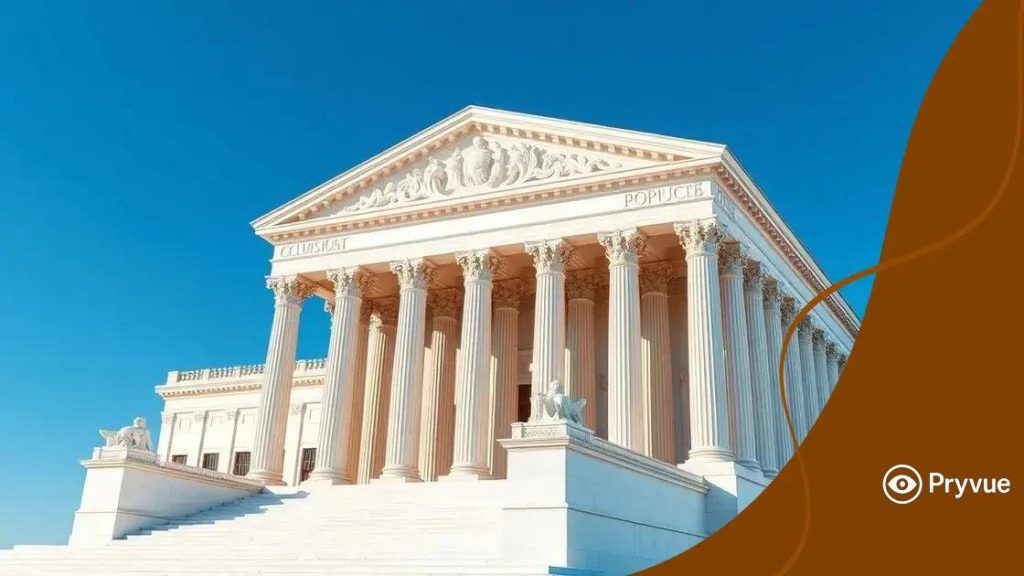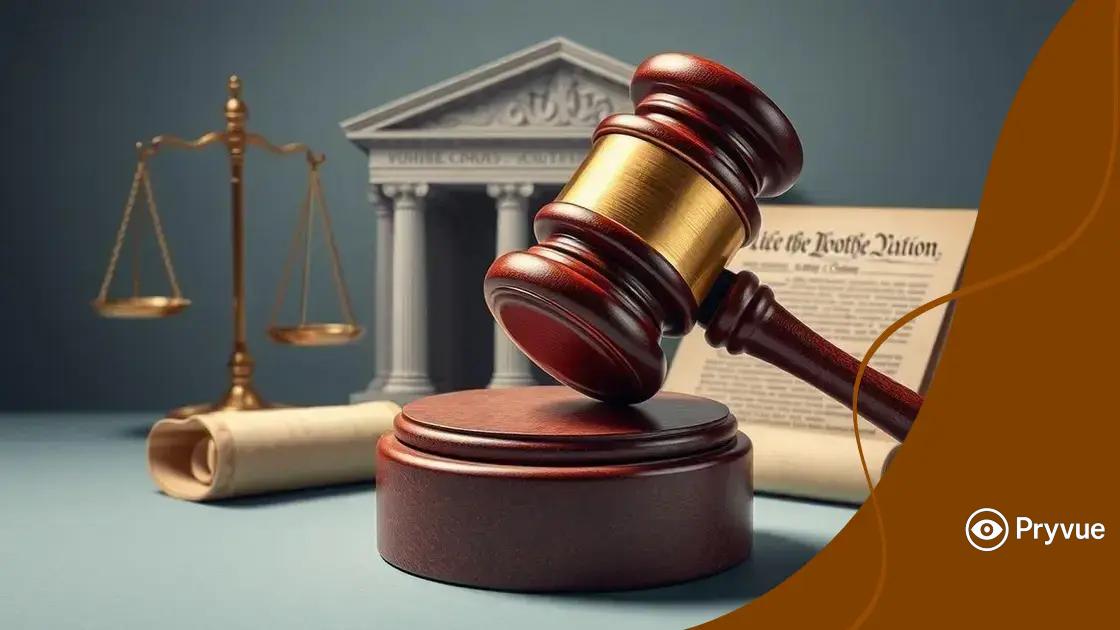Supreme Court decisions 2025: what to expect soon

Anúncios
Supreme Court decisions significantly impact individual rights and societal norms, shaping laws related to healthcare, voting, and personal freedoms, while evolving with changing societal values and technological advancements.
As we look ahead to Supreme Court decisions 2025, it’s crucial to understand their potential impact on our legal landscape. Curious about which cases might spark debates? Let’s dive in.
Anúncios
Key Supreme Court cases to watch in 2025
As 2025 unfolds, several key Supreme Court cases are set to capture attention. These cases are pivotal as they may establish new precedents and influence various aspects of law and everyday life.
Major Cases to Monitor
Legal analysts are keeping their eyes on a few cases that have significant implications. Here are some of the most anticipated cases:
- Case A: This case addresses critical issues related to constitutional rights.
- Case B: Expected to impact healthcare regulations, this case will set new standards.
- Case C: This case explores the balance of power between state and federal laws.
Each of these cases could reshape our understanding of the law and what rights we have as citizens.
Anúncios
Implications of These Cases
The outcomes of these cases will likely resonate beyond the courtroom. For instance, if the Supreme Court rules in favor of specific rights, it may set a new standard for similar cases nationwide. Conversely, a ruling against certain rights could lead to widespread changes in law enforcement and individual freedoms.
Additionally, societal reactions to these rulings could vary greatly. Advocating groups are preparing to respond, no matter the outcome, to ensure that the implications reflect the values of their constituents. Understanding the nuances of each case will be vital as we await the Court’s decisions.
Stay informed, as these hearings approach. The decisions made will likely stir debate and may have long-lasting effects on our society.
Impacts of recent decisions on American law
Recent Supreme Court decisions have had profound effects on American law. These rulings not only shape legal interpretations but also influence everyday life for citizens across the nation.
Changes in Legal Standards
One major impact is seen in how rights are defined. For instance, decisions related to personal liberties often set new precedents. These changes can affect various areas such as education, healthcare, and civil rights. It’s essential to monitor these shifts because they directly influence how laws are enforced and respected.
- Impact on Civil Rights: Rulings can strengthen or weaken protections under the Constitution.
- Legal Precedents: New decisions can create significant changes that other courts must follow.
- Public Response: Decisions often trigger widespread public opinion changes, with protests and support rallying around specific cases.
Understanding these changes is critical for citizens. The effects are often felt long after the ruling occurs. For example, changes in voting rights laws can reshape political landscapes. These legal alterations influence how individuals engage with governmental processes.
Future Implications
As further cases arise, the Court will continue to be at the center of heated debates. Each ruling has the potential to redefine what rights we hold and how they are protected. Keeping informed about these developments is crucial, as it encourages civic engagement and understanding of our legal system.
Lawyers and advocates often analyze past rulings to predict future trends. This analysis can guide actions within communities to better prepare for impending legal changes. As we gear up for upcoming cases, the stakes will only grow higher, demanding attention from all corners of the nation.
Trends in Supreme Court rulings

In recent years, trends in Supreme Court rulings have showcased shifting approaches to justice and law in the United States. Understanding these trends is vital for grasping how future cases may unfold.
Key Observations
Several noticeable patterns have emerged among the justices. More often, justices seem to lean towards a more conservative interpretation of the law. This shift impacts various aspects of society, especially concerning civil rights and liberties.
- Increased scrutiny of regulatory power: The Court has become more cautious with government regulations, often limiting their scope.
- Focus on individual rights: Rulings frequently prioritize individual freedoms over state interests, shaping new standards for personal rights.
- Partisan divisions: Decisions are often split along ideological lines, indicating how justices interpret the Constitution differently based on their backgrounds and beliefs.
These patterns not only reflect current political climates but also pave the way for future legal norms. As the Court grapples with controversial issues, the implications of these rulings can ripple through various aspects of American life.
Future Directions
Looking ahead, these trends suggest we may see continued polarization on the bench. Justices are likely to face cases that stir public sentiment, leading to high-profile decisions that attract national attention. Observing how these trends evolve will be crucial for understanding the potential landscape of American law.
The ongoing discussions surrounding these rulings are shaping public opinion and influencing legislative actions. As society engages with these issues, it’s essential to consider how current trends may affect the fundamental rights enjoyed by citizens and the overall justice system.
How Supreme Court decisions affect everyday life
Supreme Court decisions have a profound impact on everyday life in America. These rulings shape the laws that govern us, influencing everything from civil rights to personal freedoms.
Direct Impacts on Rights
When the Court makes a decision about a law, it often changes how that law is enforced. For instance, a ruling on voting rights can affect how people are allowed to vote in their states. This means that if a state changes its voting laws, it can impact who can participate in elections and how accessible the voting process is.
- Healthcare Access: Decisions regarding healthcare laws can determine who has access to critical medical services.
- Employment Rights: Rulings can influence workplace protections, affecting how companies treat their employees.
- Civil Liberties: Changes in rulings about privacy and personal freedom can alter people’s daily interactions with the law.
These decisions do not just create new regulations; they also affect people’s perceptions of their rights. As rulings are issued, public opinion can shift, leading to increased activism or advocacy efforts.
Broader Social Implications
The impact of these decisions goes beyond individual cases. They can shape social movements and spark discussions on important issues like equality and justice. For example, a landmark ruling on marriage equality not only affected the couples involved but also inspired a movement that influenced many areas of society.
As communities respond to these changes, we often see a ripple effect. People become more engaged in civic matters, advocating for their rights and the rights of others. This engagement can lead to changes in local policies and foster a more informed populace.
Understanding how Supreme Court decisions affect everyday life is crucial. It highlights the importance of being aware of legal changes and their potential consequences on personal rights and societal norms.
Predictions for future legal interpretations
The landscape of legal interpretations is constantly evolving, and emerging trends indicate possible directions for future cases. Understanding these predictions can help us grasp how laws might be applied differently in the coming years.
Emerging Trends
As the Supreme Court reviews new cases, several trends are becoming apparent. Justices are increasingly looking at the societal implications of their rulings. This focus on real-world impact suggests that future interpretations may prioritize the rights of individuals over bureaucratic procedures.
- Expansion of Personal Liberties: More cases may expand individual rights, particularly in areas like privacy and free speech.
- State vs. Federal Power: Ongoing tension between state and federal laws will likely create complex legal battles.
- Environmental and Social Justice: Legal interpretations concerning environmental issues may gain prominence, reflecting a shift towards sustainability.
These trends predict a more dynamic legal environment where societal values significantly influence judicial decisions. The importance of understanding current events cannot be overstated, as public sentiment often guides the Court’s approach.
Impact of Technology and Social Media
Technology is also reshaping the way laws are interpreted. The rise of social media and digital communication has created new legal challenges. Future rulings may need to address concerns related to online privacy, misinformation, and intellectual property. Such cases will require justices to interpret existing laws in new contexts, potentially leading to groundbreaking decisions.
As we anticipate these new interpretations, engaging in civic discussions will be crucial. Advocacy groups will play an important role in promoting certain interpretations over others, influencing how society adapts to changing legal landscapes.
Being aware of these predictions helps us prepare for possible changes in our rights and responsibilities. By understanding how the law might evolve, we can better navigate the future of our legal system.
FAQ – Frequently Asked Questions About Supreme Court Decisions
How do Supreme Court decisions affect individual rights?
Supreme Court decisions can expand or restrict individual rights, influencing various aspects of daily life such as voting, healthcare, and personal freedoms.
What trends are emerging from recent Supreme Court rulings?
Recent rulings show a trend towards prioritizing individual liberties and scrutinizing government regulations, indicating a shift in judicial philosophy.
Why is understanding these rulings important?
Understanding these rulings helps citizens stay informed about their rights and encourages engagement in civic discussions and activism.
How does technology influence legal interpretations?
Technology introduces new legal challenges, such as issues related to privacy and digital communication, which require the Court to interpret existing laws in new contexts.